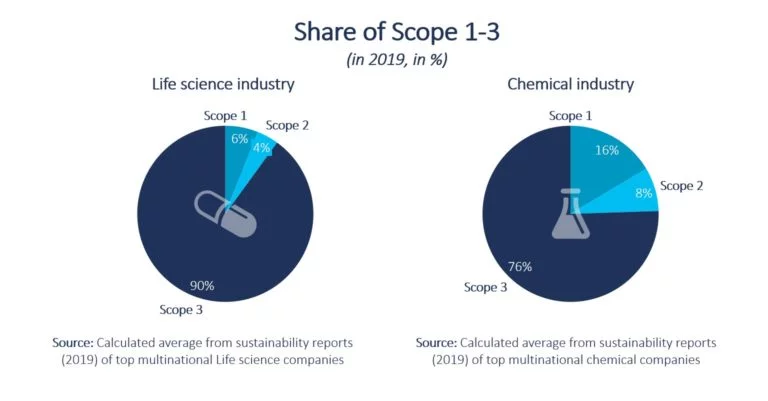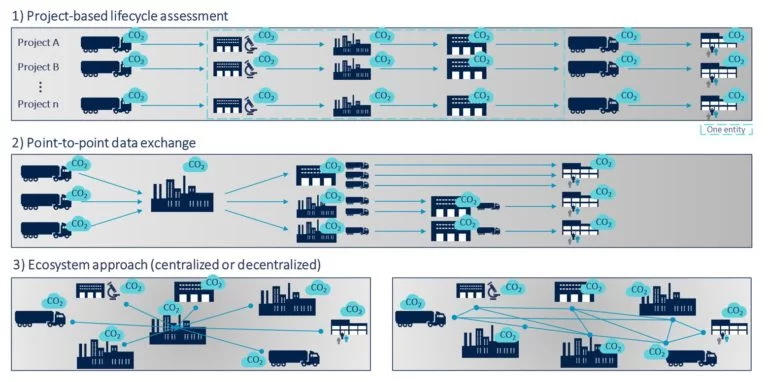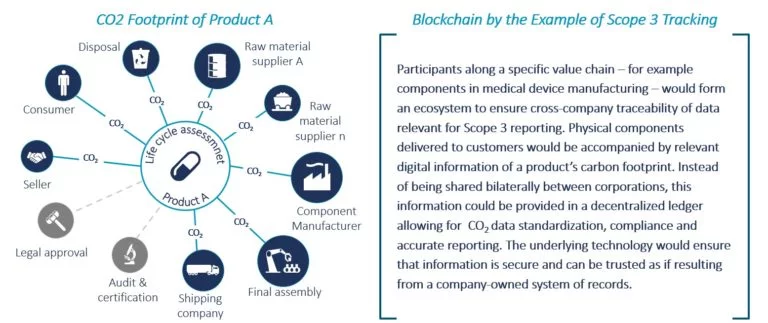
Optimizing Supply Chains: The Power of Campaign Planning
Read how the Campaign Planner & Designer (CPD) helps you to manage supply chain variability.
Inter-company CO2 tracking is crucial for reducing Scope 3 emissions but challenging to implement. Blockchain-enabled sustainability ecosystems can be a solution to this challenge, fostering collaboration and providing reliable CO2 data.
Leading companies are moving towards a more granular view on carbon footprinting, mapping CO2 and equivalents no longer just on the company, but also on the product level. This requires not only a more differentiated analysis of CO2 impacts within the four walls of a company but also a deeper understanding of the carbon footprint of purchased materials and services. Inter-company information exchange on carbon impacts (Scope 3) is still in its infancy, but digitalization and blockchain can help to make a great leap forward.
To meet the European net-zero emissions target by 2050 or earlier, all companies need to contribute by measuring and neutralizing CO2 emissions. By making carbon emissions visible on an operational level (e.g., product), companies can begin to manage and reduce them. However, net zero is still a long journey! Strategic, value chain-embedded, and digital solutions are the key drivers towards net zero. New digital concepts can provide the required infrastructure and analytical power to mitigate CO2 emissions and to generate a real strategic advantage from CO2 data.
While first industry efforts resulted in carbon transparency and reduction in the domains of Scope 1 and 2 of the Greenhouse Gas protocol, managing Scope 3 emissions across the value chain seems more troublesome. As Scope 3 has the tendency to represent ~70 to 90% of overall emissions, politics are expanding regulations on inter-organizational liabilities.

High Scope 3 emissions are predominantly caused by highly complex, specialized, and outsourced global value chains e.g., due to a large number of suppliers, integration of various parts, multi-stage production, as well as online and offline interaction. To engage in inter-company CO2 tracking, three different conceptual approaches for enabling cross-company carbon footprints are possible:

A project-based assessment is a one-time approach, for example, applied for a specific existing product, or a yearly corporate review. It requires creating operational ad-hoc transparency on CO2 data, relying on supplier information, or coming up with a pragmatic approach to assessing the CO2 values of supplied products or services. The upsides are reduced efforts of corporate footprints thanks to one-time assessments and reduced scopes narrowed down to specific products.
However, in the worst case, companies do not have available data, make no effort to collect them, calculate data inaccurately, and even hand out requested data in an unhandy format. All of this make lifecycle assessments (LCAs) costly, not scalable to the full portfolio, and a static one-time exercise.
A point-to-point data exchange connects two corporates bilaterally with each other to enable a permanent exchange of available carbon data, e.g., master data, orders, and shipments via cross-supply chain data exchange. The latter augments the received data with its own information and transfers it to the next supply chain participant. This approach is very complex as a lot of transactions complicate CO2 allocation to specific companies and products. It is very time-consuming and costly to set up individual, supplier-by-supplier interfaces with thousands of suppliers. In other words, this would require setting up many individual point-to-point interfaces to receive CO2 data and gain permanent transparency.
Challenges similar to the project-based assessment apply to point-to-point exchanges. More collaboration between all involved companies could lead to better data quality and quicker results though.
The ecosystem approach involves a participative community or network of companies and institutions willing to exchange carbon data. Multiple parties share a common infrastructure to conduct a product’s lifecycle assessment efficiently and effectively. Ecosystems can either be decentralized or centralized. While the centralized ecosystem might be beneficial for the central party, other parties often only join for fear of being cut out of business. This can be observed in manufacturing execution networks where brands have huge leverage over the participation of their OEMs. Suppliers subsequently are faced with multiplied needs to feed disparate systems at each of their customers.
The decentral ecosystem allows data to be shared only once with every network participant having access. While still operated by a central entity, the International Air Transport Association (IATA) has established such a system to exchange electronic ticket information or standards for bar-coded boarding passes. Using a decentral network reduces the number of interfaces and transactions, and therefore complexity and integration needs between participants. However, it requires a completely different collaborative approach based on a trustworthy platform.
Both ecosystem concepts face challenges of collecting data as well as allocating data to specific units (product, business units, etc.). Furthermore, the consistency of shared data needs to be ensured to be reliable and trustworthy.
When working in a decentral business ecosystem, trust towards data senders, trustworthiness of information, and transparency in the processing logic (algorithms) must be ensured.
Those characteristics outline a specific type of problem that decentralized technologies such as blockchain would be suited to solve. Blockchain as a concept and technology forms the foundation for ecosystem-wide collaboration to share previously specified and trustworthy information.
An often-neglected aspect of decentralized technologies and blockchain to succeed is the requirement to establish an ecosystem of collaborating participants beyond ‘just’ installing a piece of technology. This is where the need for Scope 3 tracking aligns with blockchain as a vehicle for achieving this along an entire business process or value chain. [1]
In a blockchain-driven ecosystem – often these go by the moniker of consortia – the community of participants is responsible for the overall outcome of the system. The Climate Change Coalition (CCC) for example advances blockchain to scale climate actions for mitigation and adaptation. One reason for the choice of technology is the ability for participants to exercise control over data while simultaneously transparency and trustworthiness of data can be ensured.

On paper, blockchain promises often read like miracle cures. In praxis, there seem to be only limited cases of successful implementations yet as there are hurdles to overcome when exchanging information of a product’s cradle-to-gate carbon footprint: Embracing decentralized concepts and technologies is a paradigm shift compared to traditional operating and business models of past centuries.
Acting collaboratively and embracing transparent working modes in ecosystems is a behavior only few companies have mastered so far. The same applies to how companies have perceived data and how they interacted with it. For a long time, information has been viewed as a source of power and potential revenue that needs to be hoarded and kept within the confinements of the company firewall.
Not to underestimate, decentralized technologies are in an early stage of their maturity lifecycle. This results in some common misconceptions such as the technology being too energy consuming or a solution in search for a problem. Thus, often blockchain is not considered a viable option to solve a business challenge. Even though its technical characteristics make it a valid choice when assessing how to tackle ecosystem challenges.
The magnitude of hurdles might seem paralyzing and daunting to get started with. However, decentralized concepts carry intrinsic benefits such as trusted data exchange while preserving information autonomy, which seem like excellent qualities to solve the systemic carbon tracking challenges. There are concrete activities to get the ball rolling and gradually improve insights while progressing towards realization.
These steps show that collaboration and multi-party coordination is necessary in parallel to technology implementation steps. It is beneficial to engage with organizations that already have experience and can support in avoiding the most common pitfalls. Reducing carbon emissions is one of the defining problems of our generation and the ones to come.
Tracking CO2 footprints is an essential step towards overcoming this situation as only gets done what is previously measured. Collaborative ecosystem activity – substantiated by decentralized technologies – is key to achieve collective CO2 tracking while simultaneously limiting individual integration and governance efforts.
[1] This is what the World Business Council for Sustainable Development (WBCSD) outlines in their “Value Chain Carbon Transparency Pathfinder”
We would like to thank Stefan Dittrich and Jean Bauer for their valuable contribution to this article.

Read how the Campaign Planner & Designer (CPD) helps you to manage supply chain variability.

Explore automated production planning with our Campaign Planner & Designer.

The pharma market trends impact logistics with a shift to smaller, higher-value shipments and new temperature requirements.

This blog post explores the role of remanufacturing and outlines how it can be successfully integrated into Product Lifecycle Management.
© Camelot Management Consultants, Part of Accenture